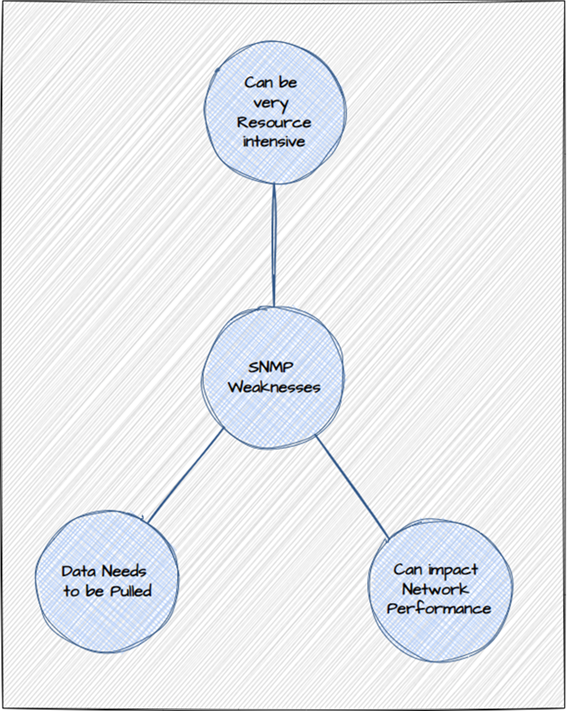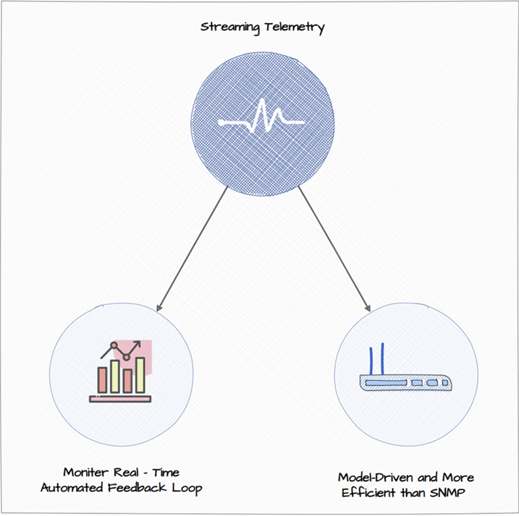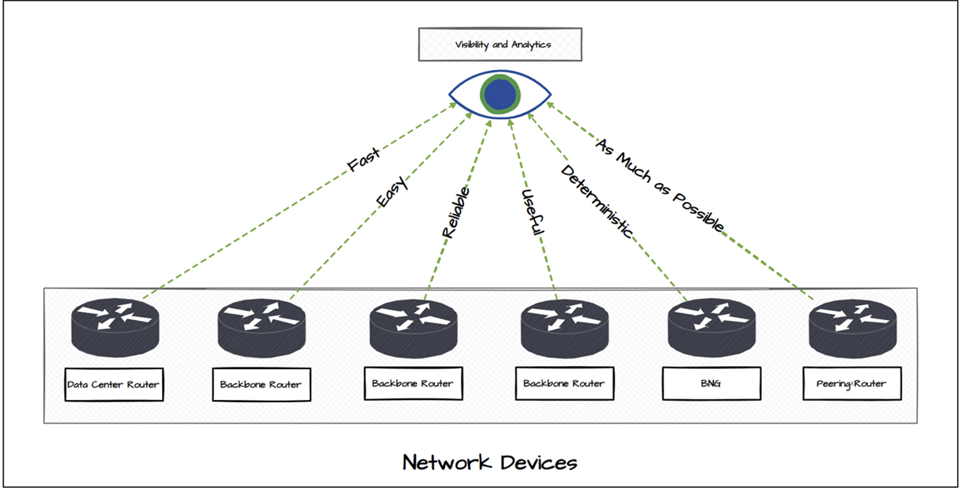Here we will discuss transport and encoding options for enabling telemetry and how to determine...
Telemetry vs. SNMP
SNMP Introduction and Challenges
Traditional networks rely on legacy mechanisms such as Simple Network Management Protocol (SNMP), Syslog, and CLI, to collect data from a network. These mechanisms have limitations that restrict automation and scale. For example, SNMP can be too slow; most organizations have polling rates set between 5 and 15 minutes, and SNMP also requires MIBs to be implemented and enrolled. In addition, these MIBs do not always support specific variables or events.
Syslog messages do not always follow a specific syntax and can require a great deal of processing to be interpreted correctly.
These traditional methods use a pull model to request information at regular intervals. The data that you collect may help you to efficiently monitor your network of a manageable size. However, as your network grows in complexity and scale, the data that you poll may be insufficient for effective monitoring. Also, the polling methods are resource-intensive and network operators face information gaps in the data that they collect. With the pull model, the network device (the server) sends data only when the data collector (the client) requests it. Initiating such requests requires continual manual intervention. The pull model/Get Bulk does not scale when there is more than one network management station (NMS) in the network. For instance, two different SNMP servers will receive different versions of monitoring data, which means lots of different requests are going through multiple SNMP servers making it more resource intensive. This manual intervention limits automation and the ability to scale, making it far from ideal. It inhibits the visibility of the network and therefore provides inefficient control of the network. Organisations need a monitoring strategy that adds resiliency and stability to network.

Some types of data cannot be monitored because the collected data might be incomplete if an MIB is not be available for a particular piece of data. Additionally, traditional tools are networking-specific and may not fit well in cloud-driven and application-driven environments.

In summary, traditional mechanisms are slow, poor scale, inefficient and unstable.
Telemetry Introduction and Advantages
Step 2: Use Netconf-console to get interface statistics such as input packets, output packets, MTU details, policer, class of service details.
Push Rather Than Pull
Telemetry gains efficiency over SNMP by eliminating the Polling process. The polling process sends requests with specific instructions that the router must process each time. Telemetry uses a router-side configured policy to recognize what data to collect, how often to collect it, and where to send it.
- Collect once, send many times
- Wait for a period of time
- Repeat the operation.
Telemetry uses a push model that automatically streams data from a network device. Instead of a collector requesting data at periodic intervals, the network device streams operational data in real time.
Telemetry focuses on the power of scale, speed, and automation. With this flexibility you can select data of interest from the network devices and transmit it in a structured format to remote management stations for monitoring. Using the finer granularity and higher frequency of data available through telemetry, DevOps engineers can quickly locate and investigate issues as soon as they occur. As such they can collaborate to monitor and have better control over the network.
In summary, pull models create resource bottlenecks that prevent retrieving valuable operational data from the router. The push model is designed to remove such bottlenecks and deliver data efficiently.

YANG
Telemetry uses YANG data models. Whilst SNMP cannot poll YANG data it can be pushed with the help of telemetry.
You can use model-driven telemetry with YANG models in two ways:
- Precisely specify what data to stream, to where, and with what encoding and transport.
- Obtain the specification of data to stream via a YANG model which contains the desired data
Real Time Data
Streamed real-time telemetry data is useful in the following situations:
- Traffic optimization: When link utilization and packet drops in a network are monitored frequently, it is easier to add or remove links, redirect traffic, modify policing, and so on. With technologies such as fast reroute, the network can switch to a new path and reroute traffic faster than the SNMP poll interval mechanism. Streaming telemetry data helps in providing quick response time for faster traffic.
- Preventive troubleshooting: It helps to quickly detect and avert failure situations that result after a problematic condition exists for a certain duration.
Telemetry is collection of measurements or other data at remote points and their automatic transmission to receiving equipment of monitoring. 
Summary
Telemetry can provide the same functions as traditional tools such as SNMP, CLIs and Syslog. For example, it can be used for monitoring network health, troubleshooting, making sure that service level agreements (SLAs) are met, capacity planning and security.
The major advantage of telemetry is that it can provide these functions in near real time. Telemetry can provide the speed, scale, and network visibility that is necessary in software-defined networks. What’s more, there are a growing number of capabilities because organizations create big data and analytical tools, including many that have been open-sourced.
To understand more about telemetry architecture and telemetry practical use case, please join our upcoming telemetry webinar.
We are also running a training course on Network Automation which is free of charge to Service Providers and those who run their own network. More details and sign up button below:

